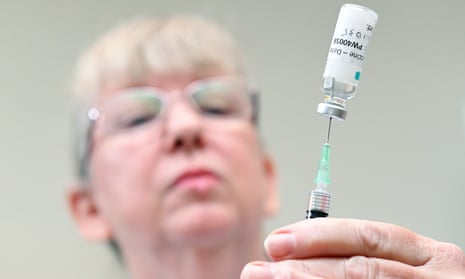It could take years to fully vaccinate Australia against Covid-19 unless there is a significant increase in the vaccination rate, a Guardian Australia analysis shows.
The federal government’s rollout strategy aims to administer 45m vaccine doses, not including vaccines for those aged under 18. At the seven-day rolling average of under 36,000, it could take almost 40 months to accomplish. Even a doubling of that rate wouldn’t see the rollout completed until the end of next year.
Professor Mary-Louise McLaws, an epidemiologist at the University of New South Wales, said the vaccination rate needs to increase quickly due to the narrow window before a second dose is required.
“The next three months is really the test for the rollout because if they can’t reach [80,000 per day] for the next three months for most of us getting our first dose, they aren’t going to cope with the second cohort needing dose number two in three months’ time,” McLaws said.
Australia may not need to administer all 45m doses to stop the virus circulating – a point called herd immunity, which is reached when there is sufficient immunity in the population such that Covid-19 cannot spread. Given Australia’s low number of cases, reaching this point would need to be done almost entirely through vaccines.
But whether herd immunity is achievable, and the threshold to reach it, is debated. Herd immunity is influenced by a number of factors including the vaccines’ effectiveness, the timing of the doses, new virus strains and whether a vaccinated person can still transmit the virus.
McLaws calculates that achieving herd immunity might require vaccinating 85% of Australians. This is based on the planned mixture of Pfizer and AstraZeneca vaccines to be used, as well as there being a three-month gap between doses.
With just over 900,000 doses already administered, and the current daily average doses, even this threshold could take several years to reach.
“Given those under 18 years will not be vaccinated until late 2021 or 2022, some vaccine hesitancy, and vaccine efficacy against infection of probably 60-90%, herd immunity will not be achieved in 2021, but could be a longer-term goal,” said Professor Gregory Dore, head of the viral hepatitis clinical research program at the Kirby Institute.
Australia has administered less than four doses for every 100 people. This is significantly lower than the United States, United Kingdom and Israel at the equivalent point in their rollouts. But the distribution is not uniform across Australia.
The Northern Territory is currently leading the way, having vaccinated about four people for every 100 residents. Western Australia and Tasmania have each vaccinated around three people per 100 residents.
The larger states are falling behind. Victoria, Queensland and New South Wales have each vaccinated less than two people for every 100 residents.
University of NSW’s Dr Mark Hanly told Guardian Australia in February that mass vaccination hubs may be necessary to augment the rollout– a policy a few of the larger states have now adopted.
This may have already made a difference, McLaws said. “I believe we have ramped that up [recently] because Victoria has, very sensibly, opened up some mass vaccination hubs for their healthcare workers.”
But the rate has to increase significantly, and quickly.
The federal government’s revised rollout has all Australians receiving a first dose by the end of the year. McLaws said even this target will require over 130,000 doses administered per day, as many of these people will also need a second dose within three months.
“The [federal] government should be put under a spotlight to roll out to 70,000 to 80,000 per day to make sure they can then handle the second cohort coming through,” McLaws said.
Notes and methods:
The Australian population is estimated to be 25,693,100 according to Australian Bureau of Statistics data. The 85% herd immunity threshold was calculated as 21,839,135.
Data on cumulative vaccinations data was sourced from CovidLive.com.au. Daily increments were calculated using the previous day’s total and then turned into a seven day rolling average.
Vaccination trends and projections were calculated by extrapolating the latest rolling average.
